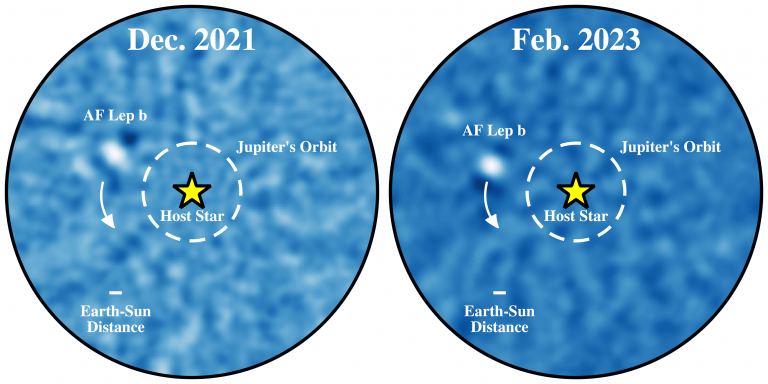In a recent study published in The Astrophysical Journal Letters, a team of astronomers used the W. M. Keck Observatory on Maunakea, Hawai?i Island to identify exoplanet, AF Lep b, which is three times the mass of Jupiter orbiting a Sun-sized star located approximately 87.5 light-years from Earth. What makes this discovery unique is AF Lep b is the first exoplanet discovered using a method called astrometry, which involves measuring unexpected, miniscule changes in the position of a star relative to nearby stars, which could indicate another object, an exoplanet, is causing gravitational tugs on its parent star.
“This is the first time this method has been used to find a giant planet orbiting a young analog of the Sun,” said Dr. Brendan Bowler, who is an assistant professor of astronomy at the University of Texas at Austin (UT Austin), and a co-author on the study. “This opens the door to using this approach as a new tool for exoplanet discovery.”
Additionally, the team used the direct imaging method to conduct follow-up observations and confirm their initial findings. This method involves slowly blotting out the star’s glare to reveal exoplanets orbiting it, just as if you were to blot out artificial light in an attempt to see objects hidden in a dark, surrounding environment.
“When we processed the observations using the Keck II telescope in real time to carefully remove the glare of the star, the planet immediately popped out and became increasingly apparent the longer we observed,” said Kyle Franson, who is a PhD student in the Department of Astronomy at UT Austin, and lead author of the study.

Using this combined method of astrometry and direct imaging helped the team not only confirm the existence of AF Lep b, but also determined its mass at approximately three times that of Jupiter, its distance from its parent star at approximately 8.4 Astronomical Units (AU), and its orbital eccentricity, which is the shape of a planet’s orbit, at approximately 0.24, which is measured from 0 to 1 with 0 being perfectly circular and 1 being a parabola. For context, Jupiter is 5.2 AU from our Sun, and its eccentricity is 0.05 while Earth is 1 AU from our Sun, and its eccentricity is 0.02.
Most exoplanets have been discovered using what’s known as the transit method, which is when an exoplanet passes in front of its parent star, thus dimming its starlight. This method not only confirms the existence of an exoplanet but can also be used to determine the mass of the exoplanet, as well.

The second most common method is the radial velocity (RV) method, which is when changes in a star’s velocity as it moves towards and away from the Earth are measured as the exoplanet orbits it. This method varies from astrometry is that RV measures a star’s velocity whereas astrometry measures a star’s change in position. Both of these methods are referred to as indirect methods as astronomers don’t directly observe the exoplanet, only how it influences its parent star throughout its orbit.
Going forward, Dr. Bowler said the team will be continuing to observe and study AF Lep b.
“This will be an excellent target to further characterize with the James Webb Space Telescope and the next generation of large ground-based telescopes like the Giant Magellan Telescope and the Thirty Meter Telescope,” said Dr. Bowler. “We’re already planning more sensitive follow-up efforts at longer wavelengths to study the physical properties and atmospheric chemistry of this planet.”
What new exoplanet discoveries will astronomers make using astrometry in the coming years and decades? Only time will tell, and this is why we science!
As always, keep doing science & keep looking up!

